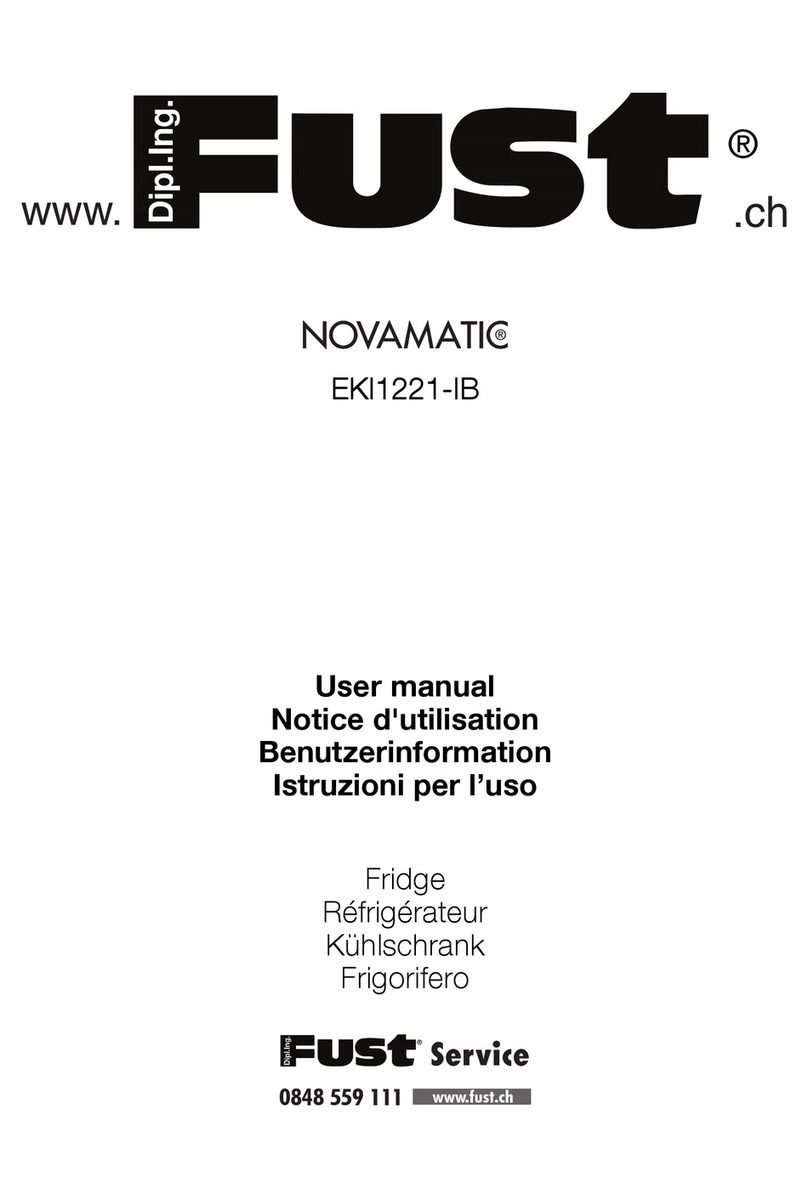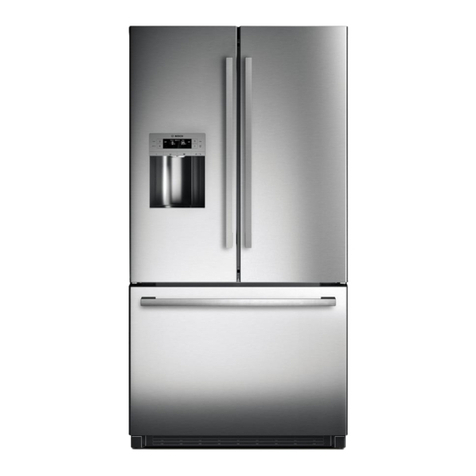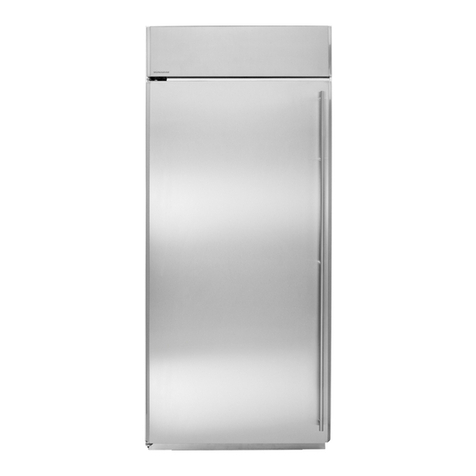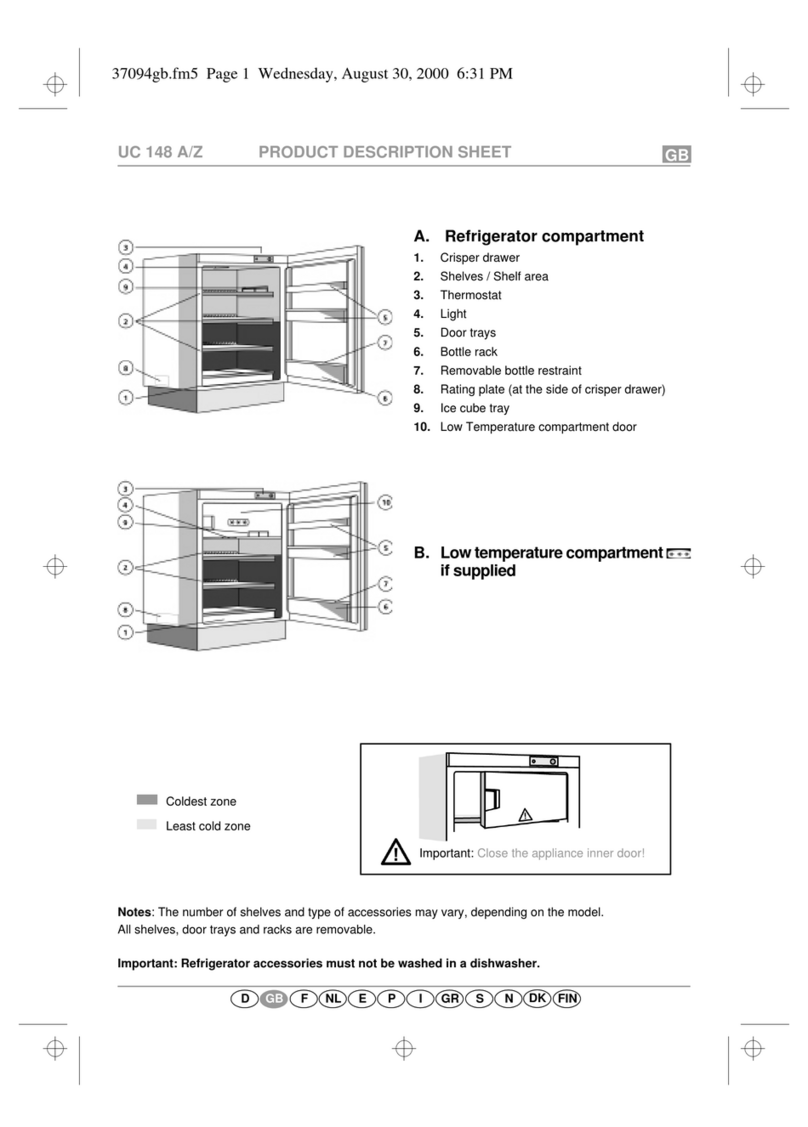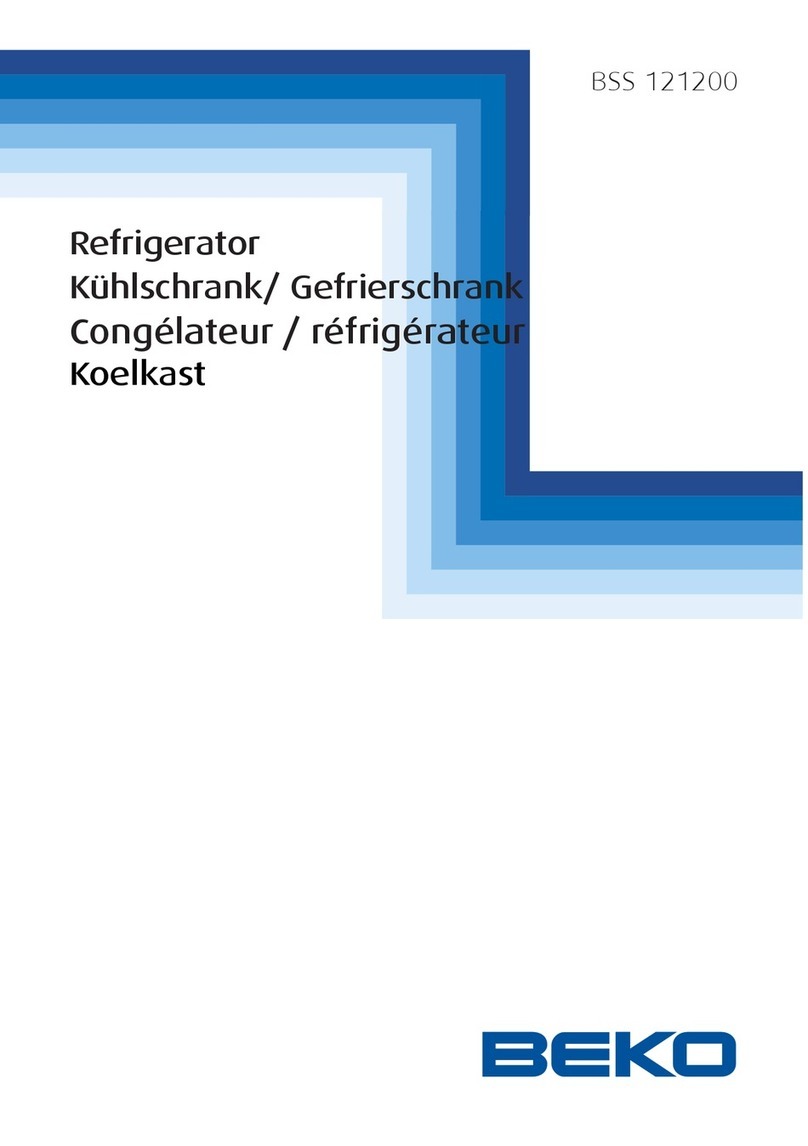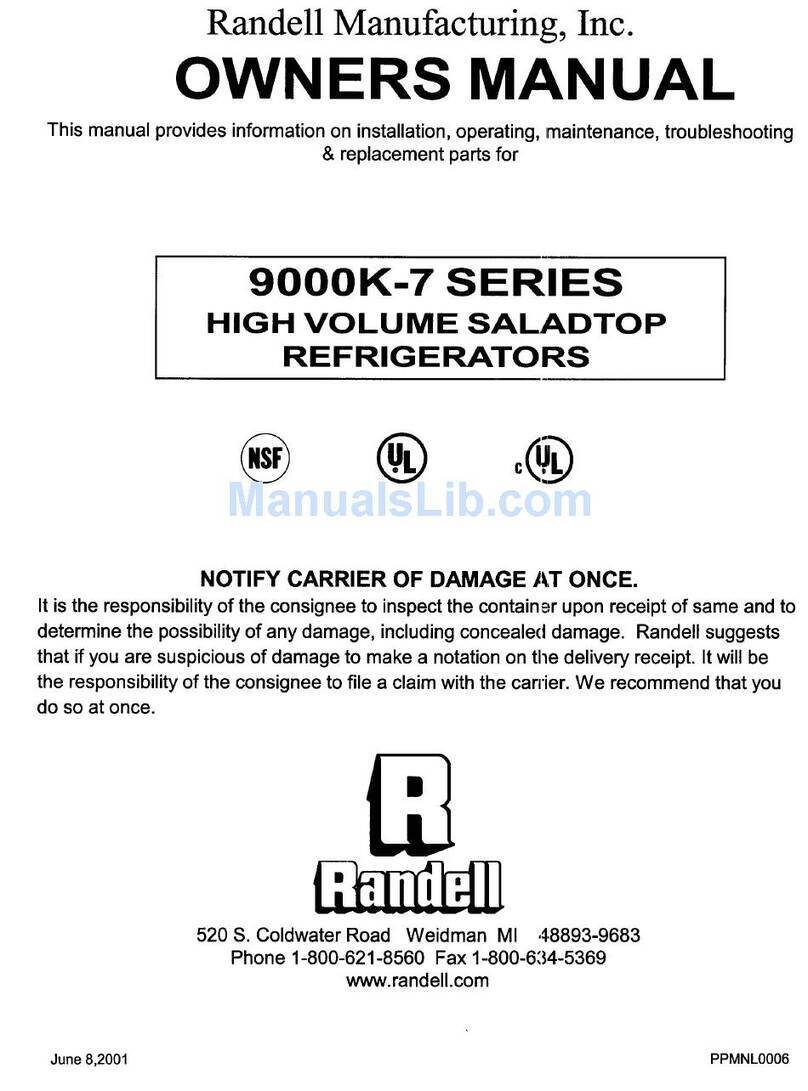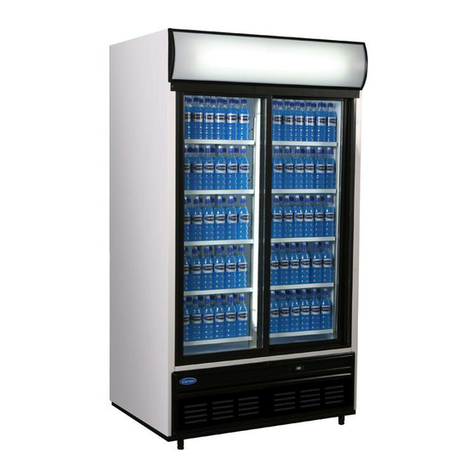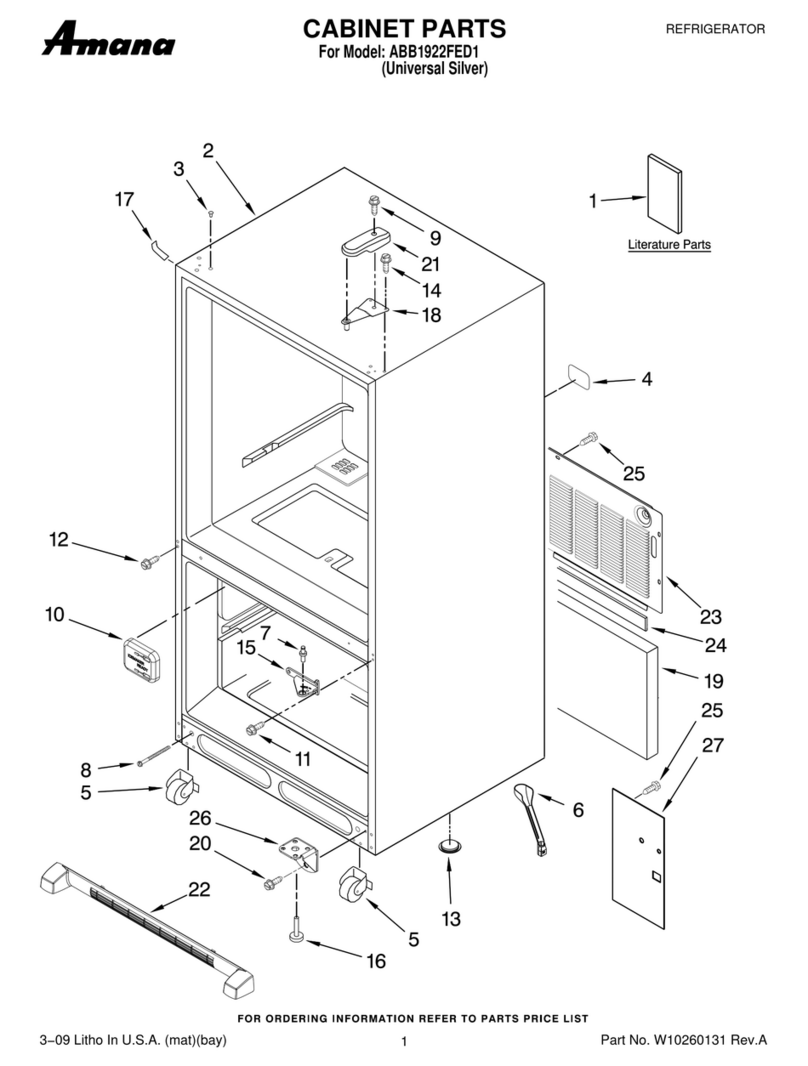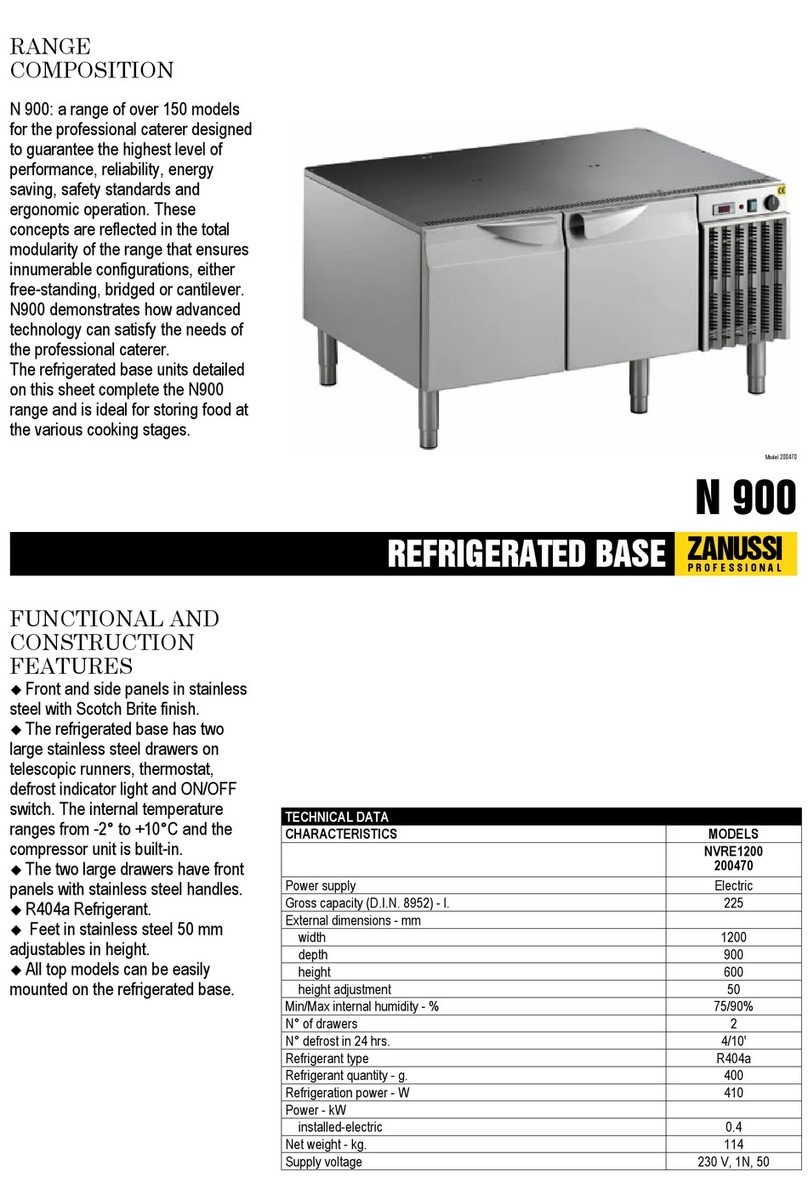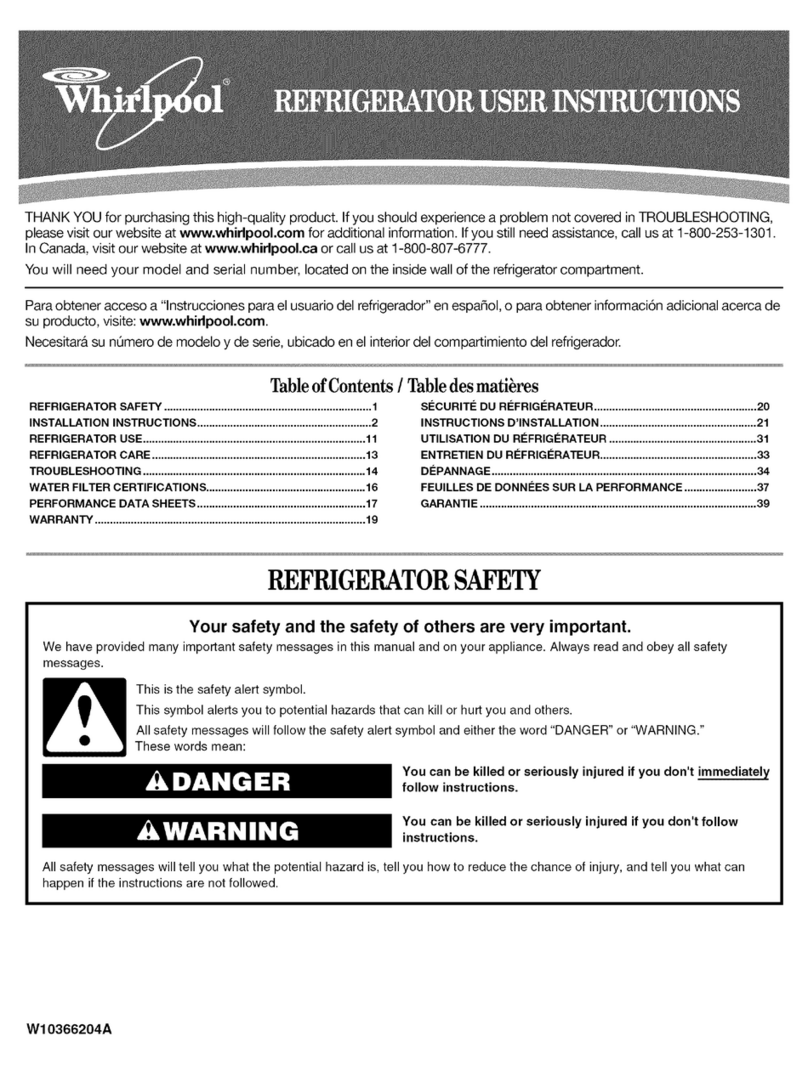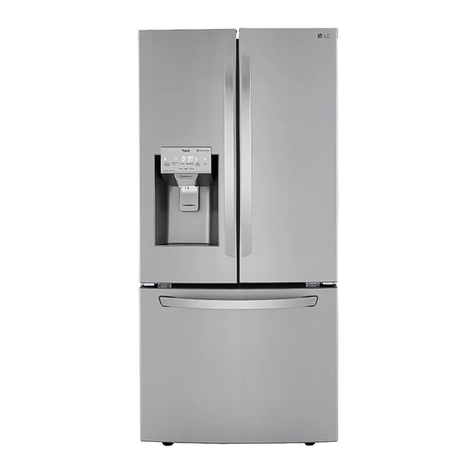Novamatic EKI 1220-IB User manual

Service-Nummer 0848 559 111
Service number 0848 559 111
Numéro de service 0848 559 111
Numero di servizio 0848 559 111
Novamatic EKI 1220-IB
Bedienungsanleitung Kühlschrank
Instructions for use refrigerator
Mode d’emploi réfrigérateur
Istruzioni per l’uso frigorifero
2222788-90

2
Sicherheitshinweise
Bevor Sie Ihr neues Kältegerät in Betrieb
nehmen, lesen Sie bitte diese
Gebrauchsanweisung aufmerksam durch.
Diese sind Sicherheitshinweise. Wir ersuchen Sie
daher, die folgenden Punkte vor der Installation
des Gerätes und seiner Inbetriebnahme
aufmerksam durchzulesen.
Es wird empfohlen, diese Gebrauchsanweisung gut
aufzubewahren und bei einem eventuellen Verkauf
des Gerätes dem neuen Besitzer auszuhändigen.
Benutzung im Haushalt
• Die Kühl- und/oder Gefrierschränke sind zur
Einlagerung und/oder zum Einfrieren von
Lebensmitteln bestimmt.
• Vor der Installation sicherstellen, dass das Gerät
nicht beschädigt ist. Mögliche Transportschäden
sind dem Händler unverzüglich mitzuteilen.
•Das Gerät ist schwer. Scharfe Metallkanten am
Gerät hinten und unten stellen ein Verletzungsrisiko
dar. Beim Aufstellen oder Verschieben sind
Schutzhandschuhe zu tragen.
• Sollte die Installation des Gerätes eine Änderung
der elektrischen Hausinstallation verlangen, so darf
diese nur von Elektro-Fachkräften durchgeführt
werden.
• Bitte prüfen, dass das Netzkabel nicht von der
Geräterückseite eingeklemmt und beschädigt wird.
Ein beschädigtes Netzkabel kann überhitzen und
einen Brand verursachen.
• Keine schweren Gegenstände bzw. das Gerät
selbst auf das Netzkabel stellen. Kurzschluss- und
Brandgefahr!
• Den Netzstecker nie am Kabel aus der Steckdose
ziehen, besonders wenn das Gerät aus der Nische
gezogen wurde. Eine Beschädigung des
Netzkabels kann Kurzschluss, Feuer und/oder
Stromschlag verursachen.
• Keine Elektrogeräte (z.B. Eismaschinen) in das
Gerät stellen.
• Es sollten keine kohlensäurehaltigen Getränke in
das Gefrier- bzw. Frosterfach eingestellt werden,
sie könnten platzen.
• Speiseeis und Eiswürfel nicht unmittelbar aus dem
Gefrierfach in den Mund nehmen. Sehr kaltes Eis
kann an Lippen oder Zunge festfrieren und
Verletzungen verursachen.
• Tiefkühlgut nicht mit nassen Händen berühren. Die
Hände könnten daran festfrieren.
• Tritt eine Störung oder ein Defekt ein, versuchen
Sie nicht, das Gerät selbst zu reparieren.
Elektrogeräte dürfen nur von Elektro-Fachkräften
repariert werden, da durch unsachgemässe
Reparaturen erhebliche Folgeschäden entstehen
können. Sich an die nächstgelegene
Kundendienststelle wenden und nur Original-
Ersatzteile anfordern.
Sicherheit für Kinder
• Die Teile des Verpackungsmaterials (z.B.
Kunststoffhüllen, Polystyrol) können für Kinder
gefährlich werden. Erstickungsgefahr!
• Im Falle der Entsorgung des Gerätes ist das
Anschlusskabel durchzutrennen und der
Türverschluss unbrauchbar zu machen, damit sich
spielende Kinder nicht im Gerät einschließen
können.
• Das Gerät darf von Kindern und Personen, deren
physische, sensorische oder geistige Fähigkeiten
sowie Mangel an Erfahrung und Kenntnissen
einen sicheren Gebrauch des Gerätes
ausschließen, nur unter Aufsicht oder nach
entsprechender Einweisung durch eine Person
benutzt werden, die sicherstellt, dass sie sich den
Gefahren des Gebrauchs bewusst sind. Kinder
sind zu beaufsichtigen, sodass sie nicht am Gerät
spielen können.
Umweltnormen
• Das Gerät darf nicht mit dem Hausmüll oder
Sperrmüll entsorgt werden. Auskunft über
Abholtermine oder Sammelplätze gibt die örtliche
Gemeindeverwaltung an.
Hinweise zur Benutzung der Gebrauchsanweisung
Die folgenden Symbole erleichtern das Lesen der Gebrauchanweisung:
Sicherheitshinweise bezüglich der Benutzung des Gerätes
Ratschläge für den korrekten Gebrauch und die optimale Ausnutzung des Gerätes.
Informationen zum Umweltschutz

Verpackungsmaterialien
• Die mit dem Symbol gekennzeichneten Materialien sind recyclingfähig.
>PE<=Polyäthylen
>PS<=Polystyrol
>PP<=Polypropylen
Sämtliche Verpackungsmaterialien sind recyclingfähig.
In Deutschland können Sie die Verpackung an den Händler zurückgeben, bei dem Sie das Gerät gekauft
haben.
Entsorgung von Altgeräten
Das Symbol auf dem Produkt oder seiner Verpackung weist darauf hin, dass dieses Produkt nicht als
normaler Haushaltsabfall zu behandeln ist, sondern an einem Sammelpunkt für das Recycling von elektrischen
und elektronischen Geräten abgegeben werden muss.
Durch Ihren Beitrag zum korrekten Entsorgen dieses Produkts schützen Sie die Umwelt und die Gesundheit
Ihrer Mitmenschen. Umwelt und Gesundheit werden durch falsches Entsorgen gefährdet. Weitere
Informationen über das Recycling dieses Produkts erhalten Sie von Ihrem Rathaus, Ihrer Müllabfuhr oder dem
Geschäft, in dem Sie das Produkt gekauft haben.
3
Sicherheitshinweise . . . . . . . . . . . . . . . . . . . . . . . . . . . . . . . . . . . . . . . . . . . . . . . . . . . . . . . . . . . . . . . . . . . . . .2
Entsorgung . . . . . . . . . . . . . . . . . . . . . . . . . . . . . . . . . . . . . . . . . . . . . . . . . . . . . . . . . . . . . . . . . . . . . . . . . . . . .3
Gebrauch Vor Inbetriebnahme . . . . . . . . . . . . . . . . . . . . . . . . . . . . . . . . . . . . . . . . . . . . . . . . . . . . . . . . . . . . . .3
Bedienungsblende / Inbetriebnhame / Temperaturregelung / Temperaturanzeige / Supercool-Funktion . . . . .4
Temperaturen / Gerät abschalten / Superfrost-Funktion . . . . . . . . . . . . . . . . . . . . . . . . . . . . . . . . . . . . . . . . . .5
Kühlabteilaustattung / Gefrierabteilausstattung . . . . . . . . . . . . . . . . . . . . . . . . . . . . . . . . . . . . . . . . . . . . . . . . .6
Tipps . . . . . . . . . . . . . . . . . . . . . . . . . . . . . . . . . . . . . . . . . . . . . . . . . . . . . . . . . . . . . . . . . . . . . . . . . . . . . . . . .7
Wartung Abtauen / Reinigung . . . . . . . . . . . . . . . . . . . . . . . . . . . . . . . . . . . . . . . . . . . . . . . . . . . . . . . . . . . . . .8
Innenbeleuchtung . . . . . . . . . . . . . . . . . . . . . . . . . . . . . . . . . . . . . . . . . . . . . . . . . . . . . . . . . . . . . . . . . . . . . . .9
Wenn etwas nicht funktioniert / Kundendienst und Ersatzteile . . . . . . . . . . . . . . . . . . . . . . . . . . . . . . . . . .9
Technische Angabe . . . . . . . . . . . . . . . . . . . . . . . . . . . . . . . . . . . . . . . . . . . . . . . . . . . . . . . . . . . . . . . . . . . . .10
Installation Aufstellung . . . . . . . . . . . . . . . . . . . . . . . . . . . . . . . . . . . . . . . . . . . . . . . . . . . . . . . . . . . . . . . . . .10
Elektrischer Anschluss . . . . . . . . . . . . . . . . . . . . . . . . . . . . . . . . . . . . . . . . . . . . . . . . . . . . . . . . . . . . . . . . . .11
Einbau . . . . . . . . . . . . . . . . . . . . . . . . . . . . . . . . . . . . . . . . . . . . . . . . . . . . . . . . . . . . . . . . . . . . . . . . . . . . . . . .11
Inhalt
Gebrauch
Vor Inbetriebnahme
Man sollte mindestens 2 Std. warten, bevor
das Gerät in Betrieb genommen wird, damit
das Kältemittel zurückströmen kann.
• Bevor Sie das Gerät in Betrieb nehmen, beseitigen
Sie den typischen «Neugeruch» am besten durch
Auswaschen der Innenteile mit lauwarmem Wasser
und einem neutralen Reinigungsmittel. Sorgfältig
nachtrocknen.
Bitte keine Reinigungs- bzw. Scheuermittel
verwenden, die das Gerät beschädigen
könnten.
Das Gerät sowie Teile der Innenausstattung sind für
den Transport geschützt.
Alle Klebebänder sowie Polsterteile aus dem
Geräteinnenraum entfernen.
Entsorgung

Bedienungsblende
4
SUPERFROST SUPERCOOL
ON/OFF
AB C DE F GHI
A -Netzkontrollanzeige
B -Taste Ein/Aus (ON/OFF)
C -Taste Temperatureinstellung (“+”=wärmer)
D -Temperaturanzeige
E -Taste Temperatureinstellung (“-”kälter)
F -SUPERFROST-Anzeige
G -SUPERFROST-Taste
H -SUPERCOOL-Anzeige
I -SUPERCOOL-Taste
Bedienung
Inbetriebnahme
• Gerätestecker in die Steckdose stecken.
• Taste EIN/AUS (B)drücken.Die grüne Netzkontroll-
anzeige (A)leuchtet.
• Auf eine der Tasten “+”(C)oder “-”(E)drücken.Die
Temperaturanzeige schaltet um und zeigt blinkend
die eingestellte SOLL-Temperatur an.
Vor dem ersten Einlagern das Gerät ca.4 Stunden
bei hoher Reglerstufe vorkühlen.
+5 °C ist die richtige Lagertemperatur für das
Kühlgut.
Temperaturregelung
• Durch Druck auf eine der beiden Tasten “+”(C)oder
“- ”(E)wird die Temperaturanzeige von der IST-
Temperatur (Temperaturanzeige leuchtet dau-
ernd) auf die SOLL-Temperatur
(Temperaturanzeige blinkt) umgeschaltet.
• Mit jedem weiteren Druck auf eine der beiden
Tasten wird die SOLL-Temperatur um 1 °C verän-
dert.
• Wird keine Taste mehr betätigt,schaltet die
Temperaturanzeige nach kurzer zeit (ca.5
sec.)auto-matisch wieder auf die IST-Temperatur
zurück.
Temperaturanzeige
Die Temperaturanzeige gibt mehrere Informationen.
• Bei normalem Betrieb wird die Temperatur ange-
zeigt, die momentan im Kühlabteil vorhanden ist
(IST- Temperatur).
• Während der Temperatureinstellung wird blinkend
die im Moment eingestellte Kühlabteiltemperatur
angezeigt (SOLL-Temperatur).
Achtung: Die Temperaturanzeige kann die tatsäch-
liche Temperatur bis zu 24 Stunden verzögert
anzeigen.
SUPERCOOL-Funktion
Die SUPERCOOL-Funktion beschleunigt das abküh-
len frischer Lebensmittel und schützt gleichzei-tig die
bereits eingelagerte Ware vor unerwünschter
Erwärmung.
Dabei wird automatisch eine SOLL-Temperatur von
+2 °C vorgegeben.
• Durch Drücken der Taste SUPERCOOL (I)wird die
SUPERCOOL-Funktion eingeschaltet. Die gelbe
Anzeige (H)leuchtet.
• Durch erneutes Drücken der Taste SUPERCOOL
kann die SUPERCOOL-Funktion jederzeit manuell
beendet werden.Die gelbe Anzeige erlischt.
• Wird die SUPERCOOL-Funktion nicht manuell
beendet,schaltet die Elektronik des Gerätes die
SUPERCOOL-Funktion nach ca.6 Std.ab.
Bei Stromausfall wird die SUPERCOOL-Funktion
ausgeschaltet!

5
Temperaturen
Im Kühlraum gibt es unterschiedliche Temperatur-
bereiche .Oben ist es am wärmsten ,auf der
Abdeckung über der Gemüseschale am kältesten.
Die Innentemperaturen werden durch folgende
Faktoren beeinflusst.
•Raumtemperatur
•Häufigkeit des Türöffnen
•Menge der eingelagerten Lebensmitteln
•Aufstellung des Gerätes
SUPERFROST-Funktion
Die SUPERFROST-Funktion beschleunigt das
Einfrieren frischer Lebensmittel und schützt
gleichzeitig die bereits eingelagerte Ware vor
unerwünschter Erwärmung.
- Durch Drücken der Taste SUPERFROST (G)wird
die SUPERFROST-Funktion eingeschaltet.Die
gelbe Anzeige (F)leuchtet.
- Durch erneutes Drücken der Taste SUPERFROST
kann die SUPERFROST-Funktion jederzeit
manuell beendet werden.Die gelbe Anzeige
erlischt.
- Wird die SUPERFROST-Funktion nicht manuell
beendet,schaltet die Elektronik des Gerätes die
SUPERFROST-Funktion nach 24 Stunden ab.Die
gelbe Anzeige erlischt.
Bei Stromausfall wird die SUPERFROST-Funktion
ausgeschaltet!
Gerät abschalten
Zum Abschalten die Taste EIN/AUS solange
gedrückt halten,bis die Temperaturanzeige erlischt.
Die gewählte Temperatureinstellung wird auch bei
einer Netzunterbrechung beibehalten.

6
Gefrierabteilausstattung
Eiswürfelbereitung
Das Gerät hat eine oder mehrere Eiswürfelschalen,
welche mit Wasser aufgefüllt in das Gefrierfach
gestellt werden.
Bitte zur Entnahme der Eiswürfelschalen
keine Metallgegenstände benutzen!
Kühlabteilausstattung
Abstellregale
• Zur Einlagerung von Lebensmittel-Packungen
verschiedener Größe, sind die Abstellregale
höhenverstellbar.
• Dazu die Abstellfläche soweit nach vorne ziehen,
bis sie sich nach oben oder unten abschwenken
und herausnehmen lässt.
• Das Einsetzen in eine andere Höhe bitte in
umgekehrter Reihenfolge vornehmen.
• Zur besseren Raumnutzung können die vorderen
Halbteile der Ablagen auf die rückwärtigen
hinaufgelegt werden.
Die Glasablage über der Gemüseschale und
die Flascheablage müssen immer in der
Stellung verbleiben, um eine korrekte
Luftzirkulation zu gewährleisten.
D338
Türabsteller
• Die Abstellregale der Innentür sind
höhenverstellbar.
• Das Abstellregal stufenweise in Pfeilrichtung
drücken bis es frei wird; dann in der gewünschten
Höhe wieder anbringen.
• Zur besseren Reinigung können die obere und die
untere Ablagen ebenfalls herausgenommen
werden.

Richtiges Kühlen
• keine warmen Speisen oder dampfenden
Flüssigkeiten in den Kühlschrank einstellen.
• Geruchverbreitende Lebensmittel müssen
abgedeckt oder eingewickelt werden.
• Die Lebensmittel müssen so eingelagert werden,
dass die Kälte um sie frei zirkulieren kann.
Nachstehend einige praktische Ratschläge:
•Fleisch (alle Sorten) in Plastikfolie einpacken und
auf die Glasplatte, die sich über der Gemüseschale
befindet, legen. In dieser Lage kann das Fleisch
längstens 1-2 Tage aufbewahrt werden.
•Gekochte Nahrungsmittel, kalte Platten, usw.
zugedeckt aufbewahren. Sie können auf jede
beliebige Glasablage gelegt werden.
•Obst und Gemüse: nach vorherigem Säubern und
Waschen in den Gemüseschalen) aufbewahren.
•Butter und Käse: in speziellen Behältern
aufbewahren oder in Alu- bzw. Plastikfolie
einpacken, um den Kontakt mit der Luft zu
vermeiden.
•Milch in Flaschen: gut verschlossen in den
Flaschenhalter der Innentür stellen.
Wenn Bananen, Kartoffeln, Zwiebeln und
Knoblauch nicht verpackt sind, sollten sie nicht
in den Kühlschrank gegeben werden.
Tipps
Energie-Einsparung
• Das Gerät nicht in der Nähe von Herden,
Heizkörpern oder anderen Wärmequellen
aufstellen. Bei hoher Umgebungstemperatur läuft
der Kompressor häufiger und länger. Bitte im
Abschnitt “Aufstellung” nachsehen.
• Tür nur so lange wie nötig geöffnet lassen.
• Höchste Kälteeinstellung bei hoher
Raumtemperatur und erheblicher
Lebensmittelmenge kann fortdauernden
Kühlschrank-Betrieb verursachen, dabei kann sich
eine Reif- oder Eisschicht an der hinteren
Innenwand bilden.
In diesem Falle den Thermostatknopf auf wärmere
Temperaturen stellen, damit das automatische
Abtauen, mit folglich geringerem Stromverbrauch,
gewährleistet werden kann.
• Keine warmen Speisen in das Gerät stellen.
Warme Speisen erst abkühlen lassen.
• Tiefkühlgut zum Auftauen in den Kühlraum legen.
Die Kälte im Tiefkühlgut wird so zur Kühlung im
Kühlraum genutzt.
• Den Verflüssiger, das Metallgitter an der
Geräterückseite, mit einem Staubsauger oder einer
Bürste immer sauber halten.
Tipps
Einfrieren und Tiefkühllagern
• Die Lebensmittel in kleine Portionen einteilen,
damit der Gefriervorgang beschleunigt wird; dies
ermöglicht das spätere Auftauen von kleineren
Portionen.
• Die Lebensmittel in Alu- oder Polyäthylenfolien
luftdicht verpacken.
• Die einzufrierenden Lebensmittel sollen mit den
Tiefkühlkosten nicht in Berührung kommen, um ein
Temperaturanstieg an diese zu verhindern.
• Speiseeis, das direkt aus dem Gefrierfach
genommen wird, kann Kälte-Brandwunden
verursachen.
• Es ist empfehlenswert, auf der Verpackung das
Einfrierdatum zu notieren, damit die
Aufbewahrungszeit eingehalten werden kann.
• Der Transport vom Verkäufer zum Verbraucher
muß in kurzer Zeit erfolgen.
•Es sollten keine kohlensäurehaltigen Getränke
in das Gefrierfach eingestellt werden, da sie
explodieren können.
• Einmal aufgetaute Lebensmittel verderben schnell
und können kein ein zweites Mal eingefroren
werden.
7

8
Abtauen
Kühlraum
• An der Rückwand des Gerätes bildet sich im
Betrieb eine Reifsicht, die in den Stillstandszeiten
des Kompressors von selbst abtaut. Das
Tauwasser läuft durch eine Rinne in eine
Plastikschale auf der Rückseite des Gerätes (über
dem Kompressor) und verdunstet dort.
• Reinigen Sie regelmäßig das Ablaufloch des
Abtauwassers. Verwenden Sie hierzu den Reiniger,
der sich schon im Ablaufloch befindet.
Reinigung
Bitte keine Reinigungs- bzw. Scheuermittel
verwenden, die das Gerät beschädigen
könnten.
Benutzen Sie nie Metallgegenstände um
das Gerät zu reinigen, da es beschädigt
werden könnte.
Den Innenraum mit lauwarmem Wasser und einem
neutralen Reinigungsmittel reinigen.
Gut nachwaschen und sorgfältig trocknen.
Stillstandszeiten
• Den Stecker aus der Steckdose ziehen. Alle
Lebensmittel herausnehmen und Gerät reinigen.
• Die Tür offen lassen, um im Inneren eine gute
Luftzirkulation zu gewährleisten und somit
Geruchsbildung zu vermeiden.
Wartung
Vor jeder Reinigungsarbeit immer den
Netzstecker aus der Steckdose ziehen.
Dieses Gerät erhält im Kaltekreislauf
Kohlenwasserstoff. Aus diesem Grund darf
die Wartung und das Nachfüllen
ausschließlich von autorisierten
Fachpersonal durchgeführt werden.
Gefrierraum
• Die Reifschicht mit dem Plastikschaber abkratzen.
• Wenn im Gefrierabteil die Eisschicht stärker als ca.
5 mm ist, tauen Sie Ihr Gerät ab.
Um ein vollständiges Abtauen durchzuführen, geht
man wie folgt vor:
• Tiefkühlgut herausnehmen, in mehrere Lagen
Zeitungspapier einpacken und abgedeckt an einem
kühlen Ort lagern.
• Drücken die Taste “B” oder Stecker aus der
Steckdose herausziehen;
• Tür offen lassen. Ein Gefäß auf den ersten Rost
direkt unter das Ablaufloch stellen. Den Stöpsel wie
in der Abbildung gezeigt entfernen.
• Nach beendetem Abtauprozess das Gefrierteil gut
nachtrocknen und den Stöpsel wieder hineingeben.
• Nach dem Abtauen, Gerät einschließlich
Innenausstattung gründlich reinigen.
• Lebensmittel einlagern und Gerät wieder in Betrieb
nehmen.
Benutzen Sie niemals Metallgegenstände,
um die Reifschicht abzukratzen, damit eine
Beschädigung des Gerätes vermieden
werden kann.
Benutzen Sie kein mechanisches oder
anderes Mittel für einen schnelleren
Abtauprozeß mit Ausnahme der vom
Hersteller empfohlenen.
PR151

Wenn etwas nicht funktioniert
Falls das Gerät Störungen aufweisen sollte, bevor Sie den Kundendienst verständigen, überprüfen Sie
zuerst folgendes:
Störung Abhilfe
Im Gerät wird es nicht kalt genug
Gerät kühlt zu stark.
Der Kompressor läuft ständig
Wasser im Kühlschrank.
Geräusche
Der Temperaturregler auf kältere Temperatur drehen.
Die Lebensmittel müssen so eingelagert werden, dass die Kälte um sie frei zirkulieren
kann.
Tür richtig schließen.
Die Umgebungstemperatur ist zu warm.
Der Temperaturregler auf wärmere Temperatur drehen.
Der Temperaturregler auf niedrigere Zahlen drehen.
Die Umgebungstemperatur ist zu warm.
Achten Sie darauf, dass diese Öffnungen nicht durch Sockelblenden oder Geschirr
abgedeckt werden.
Innerhalb der letzen 24 Std. wurden größere Mengen warmer Lebensmittel eingelagert.
Tür nur so lange wie nötig geöffnet lassen.
Die Ablauföffnung an der Rückwand im Geräteinnenraum ist verstopft. Mit einem nicht
scharfkantigen Gegenstand reinigen.
Manchmal sind sie charakterstisch für Kältegeräte.
Wenn Kältemittel in dünne Rohre einströmt, können Sie ein blubberndes oder
plätscherndes Geräusch hören.
Immer wenn der Kompressor ein- oder ausschaltet, ist ein Klicken zu hören.
Geräusche können durch das Instand setzen der Möbelstruktur entstehen.
Kundendienst und Ersatzteile
Sollten Sie nach o.e. Prüfungen zu keinem Resultat
kommen, so wenden Sie sich bitte an unseren
nächsten Kundendienst.
Um ein rasches Beheben des Schadens zu
ermöglichen, ist es beim Anruf an den Kundendienst
notwendig anzugeben:
• Modellbezeichnung
• Erzeugnis-Nummer (PNC)
• Fertigungs-Nummer (S-No.)
Diese Angaben finden Sie auf dem Typschild links an
der Innenseite des Gerätes. Damit Sie die Daten
schnell bei der Hand haben, empfehlen wir, sie hier
einzutragen.
Innenbeleuchtung
• Vor dem Lampenwechsel Gerät abschalten und
den Netzstecker ziehen.
• Um die Lampe su wechseln, drücken die hintere
Kupplung und gleichzeitig nehmen die Abdeckung
in der Pfeilrichtung heraus.
Ersetzen durch eine neue Birne gleicher
Leistung (die maximale Leistung ist am
Leuchtkörper angegeben).
9

Technische Angabe
Die technischen Angaben sind auf dem Typschild genannt, das auf der linken inneren Seite der Anlage liegt.
Im Falle einer Stromunterbrechung während der Lagerung von Tiefkühlkost bzw. von
eingefrorenen Lebensmitteln soll die Tür des Gefrierfaches nicht geöffnet werden. Die
Tiefkühlkost verdirbt nicht, wenn es sich um eine kurze Unterbrechung handelt (12 Std.) und das
Gerät voll ist. Wenn das nicht der Fall ist, ist es nötig, die tiefgefrorenen Lebensmittel innerhalb
kurzer Zeit zu verbrauchen (eine Temperaturerhöhung der Tiefkühlkost verkürzt die
Aufbewahrungsdauer).
10
Installation
Aufstellung
• Vor der Installation sicherstellen, dass das Gerät
nicht beschädigt ist. Mögliche Transportschäden
sind dem Händler unverzüglich mitzuteilen.
•Das Gerät darf nicht in unmittelbarer Nähe von
Heizkörpern oder sonstigen Wärmequelle
aufgestellt werden.
• Ein Standort mit direkter Sonneneinstrahlung sollte
vermieden werden.
• Eine ausreichende Luftzirkulation an der
Geräterückseite muss gewährleistet sein.
• Für eine optimale Belüftung des Gerätes müssen
die minimalen Lüftungsquerschnitet (Abb.)
eingehalten werden.
Achtung: Die Ventilations - Öffnungen müssen
immer saubergehalten werden.
Ferner ist auch am hinteren Einbauschrankteil ein
Lüftungskamin mit folgenden Massen notwendig:
Tiefe 50 mm
Breite 540 mm
Vor der Installation sicherstellen, dass das
Gerät nicht beschädigt ist. Mögliche
Transportschäden sind dem Händler
unverzüglich mitzuteilen.
• Während das Gerät in Betrieb ist, werden der
Verflüssiger und der Kompressor, die sich auf der
Rückseite des Gerätes befinden, heiß. Aus
Gründen der Sicherheit muss eine
Mindestbelüftung gesichert sein. Siehe
Aufstellungsanweisungen.
•Wichtig: Beschädigte Versorgungskabel müssen
durch ein Spezialkabel bzw. einen Spezialsatz
ersetzt werden, die beim Hersteller oder dem
Kundendienststellen erhältlich sind.
50 mm
min.
200 cm
2
200 cm
2
min.
D526
Zu beachten: Wird dieses Gerätes bei anderen
Umgebungstemperaturen betrieben als den in der
entsprechenden Klimaklasse angegebenen Werten,
sind folgende Hinweise zu beachten: sinkt die
Umgebungstemperatur unter den angegebenen
Mindestwert ab, könnte die Lagertemperatur im
Gefrierabteil nicht mehr garantiert sein; es wird daher
empfohlen, die eingelagerten Lebensmittel so rasch
als möglich zu verbrauchen.
Die Klimaklasse finden Sie auf dem Typschild, das
sich links im Innenraum des Gerätes befindet.
Nachstehende Tabelle zeigt, welche
Umgebungstemperatur welcher Klimaklasse
zugeordnet ist:
Klimaklasse
SN +10 bis +32°C
+16 bis +32°C
+18 bis +38°C
+18 bis +43°C
N
ST
T
für Umgebungstemperatur von

11
Dieses Gerät entspricht der folgende EWG Richtlinie:
- 73/23 EWG vom 19.2.73 (Niederspannung)
und folgende Änderungen;
- 87/308 EWG vom 2.6.87 (Funkentstörung);
- 89/336 EWG vom 03/05/89 (Elektromagne-
tische Verträglichkeit) und folgende
Änderungen.
Wichtig
Es muss möglich sein, das Gerät vom Netz zu
trennen; nach der Installation muss die
Steckdose daher zugänglich bleiben.
Elektrischer Anschluss
Bevor Sie den Stecker in die Steckdose einstecken,
überprüfen Sie bitte, dass die auf dem Typschild des
Gerätes angegebene Spannung sowie Frequenz mit
dem Anschlusswert des Hauses übereinstimmen.
Eine Abweichung von ±6% von der
Nominalspannung ist zulässig.
Für die Anpassung des Gerätes an andere
Spannungen muss ein Spartransformator
angemessener Leistung vorgeschaltet werden.
Wichtig
Das Gerät muss unbedingt
vorschriftsmäßig geerdet werden.
Zu diesem Zweck ist der Stecker des
Anschlusskabels mit dem dafür vorgesehenen
Kontakt versehen. Sollte die Netzleitung im
Haus nicht mit einer Erdleitung versehen sein,
so muss das Gerät an eine getrennte
Erdleitung vorschriftsmäßig und unter
Hinzuziehung eines Fachmanns
angeschlossen werden.
Die Erzeugerfirma lehnt jede
Verantwortung ab, falls diese
Unfallverhütungsvorschrift nicht beachtet
wird.
Einbau
Siehe beiliegende Montageanweisung.
Prüfen Sie bitte nach dem Einbau des Geräts,
insbesondere nach Türanschlagwechsel, ob die
Türdichtung ringsum richtig abdichtet. Eine undichte
Türdichtung kann zu verstärkter Reifbildung und
dadurch zu höherem Energieverbrauch führen.
Achtung!
Bei einer niedrigen Raumtemperatur (z.B. im
Winter) kann es vorkommen, dass die
Dichtung nicht perfekt am Schrank haftet. Die
Wiederherstellung der Dichtung erfolgt
automatisch nach gewisser Zeit. Wollen Sie
aber diesen Prozess beschleunigen, so
genügt es die Dichtung mit einem Fön zu
erwärmen.
Maßzeichnung

12
Instructions for the use of the instructions booklet
Notes which are important for your safety or for the proper functioning of the appliance
Supplementary information regarding operation and practical applications of the appliance.
Tips and notes concerning economical and environmentally sound use of the appliance
adults only. Do not allow the children to tamper with
the controls or play with the products. There is a
risk of suffocation! Keep packaging material away
from children!
• This appliance is not intended for use by persons
(including children) with reduced physical, sensory
or mental capabilities, or lack of experience and
knowledge, unless they have been given
supervision or instruction concerning use of the
appliance by a person responsible for their safety.
Children should be supervised to ensure that they
do not play with the appliance.
Environment Protection
• This appliance does not contain gasses which
could damage the ozone layer, in either its
refrigerant circuit or insulation materials. The
appliance shall not be discarded together with the
urban refuse and rubbish. Avoid damaging the
cooling unit. Information on your local disposal
sites may be obtained from your municipal
authorities.
Remove the plug and ensure that any locks or
catches are removed, to prevent young children
being trapped inside.
Safety Instructions
This information has been provided in the interests of your safety. Please read it before installing or
using the appliance. Please retain the instruction book for future reference. If owner ship is transferred,
please leave the user manual for the new owner.
Domestic Use
• The domestic refrigerators and freezers are
designed to be used specifically for the storage of
edible foodstuffs only.
• Check the appliance for transport damage. Under
no circumstances should a damaged appliance be
installed. In the event of damage please contact
your retailer.
• This appliance is heavy. The edges and projecting
parts of the cabinet may be sharp. Be careful when
moving the cabinet and always use gloves.
• Any electrical work required to install this appliance
should be carried out by a qualified electrician or
competent person.
• Make sure that the power plug is not squashed or
damaged by the back of the appliance. Make sure
that the cable is not trapped underneath the
appliance, nor touches the motor.
• Do not remove the power cord by pulling on its
lead, particularly when the appliance is being
pulled out of its niche. If the power plug socket is
loose, do not insert the power plug. Damage to the
cord may cause a short-circuit, fire and/or electric
shock.
• Do not use electrical appliances inside the
appliance.
• Do not keep carbonated drinks or bottles in the freezer
compartment. The glass bottles may break.
• Ice lollies can cause ‘frost/freezer burns’ if
consumed straight from the freezer.
• It is dangerous to try and alter the specifications or
modify this product in any way.
• Under no circumstances should you attempt to
repair the appliance yourself. Refer to your local
Service Centre, and always insist on genuine spare
parts.
Child Safety
• This appliance is designed to be operated by
Disposal
Appliance Packaging Information
• The materials marked with the symbol are
recyclable.
>PE< for polyethylene, e.g. sheet wrapping
material
>PS< for polystyrene, e.g. padding material
(always CFC-free)
>POM< polyoxymethylene, e.g. plastic clips.
All materials are environmentally sound!

Contents
Safety Instructions / Disposal . . . . . . . . . . . . . . . . . . . . . . . . . . . . . . . . . . . . . . . . . . . . . . . . . . . . . . . . . . . . .12
Use and Control Before Use . . . . . . . . . . . . . . . . . . . . . . . . . . . . . . . . . . . . . . . . . . . . . . . . . . . . . . . . . . . . . .13
Control panel /Starting the appliance /Temperature adjustement /Temperatur indicator / Supercool-Function 14
Switching off th appliance / Superfrost function . . . . . . . . . . . . . . . . . . . . . . . . . . . . . . . . . . . . . . . . . . . . . . . .15
Internal parts . . . . . . . . . . . . . . . . . . . . . . . . . . . . . . . . . . . . . . . . . . . . . . . . . . . . . . . . . . . . . . . . . . . . . . . . .16
Hints . . . . . . . . . . . . . . . . . . . . . . . . . . . . . . . . . . . . . . . . . . . . . . . . . . . . . . . . . . . . . . . . . . . . . . . . . . . . . . . .17
Maintenance Defrosting / Cleaning / Changing the light bulb . . . . . . . . . . . . . . . . . . . . . . . . . . . . . . . . . . . . .18
Something not Working / Customer Service and Spare Parts / Technical Specifications . . . . . . . . . . . .19
Installation Positioning / Electrical connection . . . . . . . . . . . . . . . . . . . . . . . . . . . . . . . . . . . . . . . . . . . . . . . . .20
Building-in . . . . . . . . . . . . . . . . . . . . . . . . . . . . . . . . . . . . . . . . . . . . . . . . . . . . . . . . . . . . . . . . . . . . . . . . . . . . .21
Use and Control
Before Use
Wait two hours before connecting the
appliance to allow the oil to flow back in the
compressor.
• Before using the appliance for the first time, wash
the interior and all internal accessories with
lukewarm water and some neutral soap so as to
remove the typical smell of a brand-new product,
then dry thoroughly.
Do not use detergents or abrasive
powders, as these will damage the finish.
• Remove safety elements used for transportation.
Disposal of old appliances
The symbol on the product or on its packaging indicates that this product may not be treated as
household waste. Instead it shall be handed over to the applicable collection point for the recycling of electrical
and electronic equipment. By ensuring this product is disposed of correctly, you will help prevent potential
negative consequences for the environment and human health, which could otherwise be caused by
inappropriate waste handling of this product. For more detailed information about recycling of this product,
please contact your local city office, your household waste disposal service or the shop where you purchased
the product.
13

14
SUPERFROST SUPERCOOL
ON/OFF
AB C DE F GHI
Control panel
A -Mains operation indicator
B -ON/OFF button
C -Temperature setting button (.+.=warmer)
D -Temperature indicator
E -Temperature setting button (.-.colder)
F -SUPERFROST indicator
G -SUPERFROST button
H -SUPERCOOL indicator
I -SUPERCOOL button
Using
Starting the appliance
• Plug it into the socket.
• Press the EIN/AUS (B)(ON/OFF)button.The mains
operation indicator (A)lights up.
• Press one of the .+.(C)or .-.(E)buttons.The
temperature indicator goes into operation and
indicates the set nominal temperature.
If the regulator is set at a higher level,wait about 4
hours before loading the appliance.
The right temperature for loading food products to be
cooled is +5 °C.
Temperature adjustment
• By pressing one of the .+.(C)or .-.(E)buttons it is
possible to switch from the actual temperature (the
temperature indicator is lit and remains
stationary)to the nominal temperature (the
temperature indicator blinks).
• By continuing to press one of the buttons,the
nominal temperature changes 1 °C.
• If no button is pressed,the temperature indicator
automatically returns to the actual temperature
after about 5 seconds.
Temperature indicator
The temperature indicator gives a variety of
information.
• During normal operation,it shows the temperature
inside the refrigerator compartment.(actual
temperature).
• When setting the temperature,the temperature set
for the refrigerator compartment (nominal
temperature) at that moment blinks.
Caution:as many as 24 hours may be required
before the temperature indicator shows the actual
temperature.
SUPERCOOL function
The SUPERCOOL function speeds up the cooling of
fresh food products while at the same time protecting
those already stored from undesirable heating.A
nominal temperature of +2 °C is automatically
preset.
• The function turns on by pressing the
SUPERCOOL button (I).The yellow indicator
(H)lights up.
• It is possible to stop this function at any time by
pressing the SUPERCOOL button once again.The
yellow indicator turns off.
• If the SUPERCOOL function does not stop
manually, it is automatically cut off electronically
after about 6 hours.
The SUPERCOOL function is deactivated if the elec-
tric current is cut off!
Temperature
There are different temperature zones in the
refrigerator compartment.The warmest zone is at the
top,and the coldest zone is above the cover of the
vegetable bins.
The internal temperature is influenced by the
following factors:
•Room temperature
•How often the door is opened
•Amount of food products stored
•Appliance setting

15
SUPERFROST function
The SUPERFROST function speeds up the freezing
of fresh food products while at the same time
protecting those already inside the compartment
from undesirable heating.
- The function turns on by pressing the
SUPERFROST button (G).The yellow indicator
(F)lights up.
- It is possible to manually stop this function at any
time by pressing the SUPERFROST button once
again.The yellow indicator turns off.
- If the SUPERFROST function does not stop
manually, it is automatically cut off electronically
after about 24 hours.The yellow indicator turns off.
The SUPERFROST function is deactivated if the
electric current is cut off!
Switching off the appliance
To switch off the appliance,keep the EIN/AUS
(ON/OFF) button pressed until the temperature
indicator turns off.
The selected temperature setting is stored,even if
the electric current is cut off.

16
Freezer Accessories
Ice-cube production
This appliance is equipped with one or more trays for
the production of ice-cubes.
Fill these trays with water, then put them in the
freezer compartment.
Do not use metallic instruments to remove
the trays from the freezer.
Door shelves
• To permit storage of food packages of various
sizes, the central door shelf can be adjusted in
height.
• Gradually pull the shelf in the direction of the
arrows until it comes free, then reposition as
required.
• For more thorough cleaning, the top and bottom
door sheves can be easily removed and refitted in
position.
Internal Parts
Storage shelves
• The shelves can be removed for cleaning.
• To permit storage of food packages of various
sizes, the shelves can be placed at different
heights.
• To remove the internal shelf pull forward until it can
be tipped up or down and removed.
• Please do the same in reverse to insert the shelf at
a different height.
• For better use of space, the front half-shelves can
lie over the rear ones.
The glass shelf above the vegetable drawers
and the bottle shelf should always remain in
position, to ensure correct air circulation.
D338

Hints
Saving Energy
• Pay careful attention to where the cabinet is
placed. See the section “Installation”. When
installed correctly the cabinet will consume less
energy.
• Try to avoid keeping the doors open for long
periods or opening the doors too frequently as
warm air will enter the cabinet and cause the
compressor to switch on unnecessarily often.
• If the ambient temperature is high, the thermostat
knob is on the coldest setting (higher numbers) and
the appliance is fully loaded, the compressor may
run continuously, causing frost or ice to form on the
evaporator. If this happens, turn the knob to a
warmer setting (lower numbers) to allow automatic
defrosting and so a saving in electricity
consumption.
• Do not place warm foods inside the appliance.
Allow warm foods to cool first.
• Put frozen food in the fridge to defrost. The cold in
the frozen food will then be used to cool the fridge.
• Keep the heat emitting condenser, the metall grille
on the rear wall of your appliance, always clean.
17
Hints for refrigeration
•Do not store warm food or evaporating liquids in
the refrigerator and do cover or wrap up the food,
particularly if it has a strong smell.
To help you use your refrigerator correctly, here are
some useful hints:
•Raw meat (beef, pork, lamb & poultry): wrap in
polythene bags and place on top of the salad
compartment, this being the coldest spot in the
refrigerator. Meat can only be stored safely in
this way for one or two days at the most.
•Cooked food, cold cuts, jelly, etc.: these should
be well covered and can be stored on any of the
glass shelves.
•Fruit & vegetables: these should be thoroughly
cleaned and placed in the bottom drawer/s.
•Butter & cheese: these should be placed in
special airtight containers or wrapped in aluminium
foil or polythene bags to keep out as much air as
possible.
•Milk bottles: these should have a top and should
be stored in the bottle rack on the door.
Bananas, potatoes, onions and garlic, if not
packed, must not be kept in the refrigerator.
Hints
Freezing of fresh food and storage of frozen food
• Prepare food in small portions to enable it to be
rapidly and completely frozen and to make it
possible subsequently to thaw only the quantity
required.
• Wrap up the food in aluminium foil or polythene
and make sure that the packages are airtight.
• Do not allow fresh, unfrozen food to touch food
which is already frozen, thus avoiding a rise in
temperature of the latter.
• Do not touch frozen food with wet hands. Your
hands could stick to the food and cause skin
abrasions.
• It is advisable to show the freezing-in date on each
individual pack to enable you to keep tab of the
storage time.
• Be sure that frozen foodstuffs are transferred from
the foodstore to the freezer in the shortest possible
time.
•Do not put carbonated liquids (fizzy drinks,
etc.) in the freezing compartment as they may
burst.
• Once defrosted, food deteriorates rapidly and
cannot be refrozen.

Cleaning
Never use metal objects for cleaning your
appliance as it may get damaged.
NEVER use detergents, abrasive powders,
highly perfumed cleaning products or wax
polishes to clean the interior as these will
damage the surface and leave a strong
odour.
Clean the inside with warm water and bicarbonate of
soda. Rinse and dry thoroughly.
Defrosting
Refrigerator compartment
• Defrosting the refrigerator compartment is
automatic. The defrost water drains out through a
trough into a container at the back of the appliance,
above the motor compressor, where it evaporates.
• It is important to periodically clean the defrost
water drain hole.
Maintenance
Unplug the appliance before carrying out
any maintenance operation.
Warning
This appliance contains hydrocarbons in its
cooling unit maintenance and recharging must
therefore only be carried out by authorised
technicians.
When the appliance is not in use
Disconnect the appliance from the electricity supply.
Empty all foods and clean the appliance, leaving the
doors ajar to prevent unpleasant smells.
Freezer compartment
• Remove the frost with a plastic scraper.
• Whenever the thickness of the frost exceeds 5 mm
complete defrosting should be carried out.
Prooceed as follows:
• Remove any stored food, wrap it in several layers
of newspaper and put it in a cool place.
• Press the button “B” or pull out the plug from the
wall socket
• Leave the door open, place a basin on the top shelf
of the refrigerator compartment, under the drain
hole, remove the plug as shown in the figure.
PR151
• When defrosting is completed, dry the interior
thoroughly and refit the plug.
• Turn the thermostat knob back to the required
setting or replace the plug in the power socket.
• Reload the previously removed food into the
compartment.
Never use sharp metal tools to scrape off
frost from the evaporator as you could
damage it.
Do not use a mechanical device or any
artificial means to speed up the thawing
process other than those recommended by
the manufacturer.
Changing the light bulb
• Should the interior light fail to work, first switch off
the appliance and disconnect from the electricity
supply.
• Press on the rear hook and at the same time slide
the cover in the direction indicated by the arrow.
Replace the lamp with one of the same power
(the maximum power is shown on the light
diffuser).
18

Technical specifications
The technical data is indicated in the rating plate on the left side inside the appliance.
If there is a power failure when food is in the freezer, do not open the door of the freezer
compartment. The frozen food will not be affected if the power cut is of short duration (up to 12
hours) and the freezer compartment is full, otherwise, it is recommended that the food should be
used within a short time (a temperature increase of the frozen food shortens its safe storage
period).
Something not Working
19
Problems may be due to causes which can easily be solved before calling the Technical Service. Please
follow these instructions:
Weight surpasses the storage limit of the door shelf so spread weight more evenly or
take some products out.
The appliance is not properly installed. Please look in the “Building-in” section.
Set a lower temperature.
Distribute the food products to allow cold air to circulate around them.
Make sure that the door is completely closed and that the insulating strip is complete
and clean.
The temperature where the cabinet is placed is above normal room temperature.
Turn the temperature regulator to a warmer setting temporarily.
Turn the temperature regulator to a lower number.
The temperature where the cabinet is placed is above normal room temperature.
Check that the ventilation is sufficient and that the ventilation openings are
unobstructed.
The cause could be the introduction of large quantities of food and/or frequent
opening/closing of the door.
Sometimes is normal. During automatic defrosting frost thaws on the cooling plate.
Place the drain hose at the back of the cabinet above the drain bowl.
Sometimes this is normal. Temperature control may cause clicking sounds when the
system is connected or disconnected.
The injected cooling gas may produce a gurgling sound while passing through the
tubes.
The motor may cause a humming noise and/or slight bumping.
The insulation material used has a tendency to slighly increase noise levels, how ever it
allows for much better insulation and a lower energy consumption.
Door does not close
It is too warm inside the refrigerator
It is too cold inside the refrigerator.
The compressor works continuously.
There is water inside/outside the refrigerator.
Water comes out on the floor.
Noises
SYMPTOM SOLUTION
appliance information:
• Model Name
• Model Number (PNC)
• Serial Number (S-No.)
This information can be found on the rating plate
inside the cabenit on the left hand wall. We
recommend that you enter this information here, so
that it is handy if needed.
If you cannot find the remedy for a malfunction in
these operating instructions, please contact your
dealer or our customer service department and
consult the Guarantee card.
Selective ordering of replacement parts can save
unnecessary travel and costs.
For this reason always provide the following
Customer service and spare parts

Electrical connection
Before plugging in, ensure that the voltage and
frequency shown on the serial number plate
correspond to your domestic power supply.
Voltage can vary by ±6% of the rated voltage.
For operation with different voltages, a suitably sized
auto-transformer must be used.
Important
The appliance must be earthed.
The power supply cable plug is provided with a
contact for this purpose.
If the domestic power supply socket is not
earthed. connect the appliance to a separate
earth in compliance with current regulations,
consulting a specialist technician.
The Manufacturer declines all
responsibility if the above safety
precautions are not observed.
This appliance complies with the following E.E.C.
Directives:
- 87/308 EEC of 2/6/87 relative to radio
interference suppression.
- 73/23 EEC of 19.2.73 (Low Voltage
Directive)
and subsequent modifications.
- 89/336 EEC of 3.5.89 (Electromagnetic
Compatibility Directive) and subsequent
modifications.
Attention!
It must be possible to disconnect the appliance
from the mains power supply; the plug must
therefore be easily accessible after installation.
20
Installation
Take utmost care when handling your
appliance so as not to cause any damages to
the cooling unit with consequent possible fluid
leakages.
• During normal operation, the condenser and
compressor at the back of the appliance heat up
considerably. Always ensure that there is adequate
ventilation as a failure to do this will result in
component failure and possible food loss. See
installation instructions.
•Important: if the supply cord is damaged, it must
be replaced by a special cord or assembly availa-
ble from the manufacturer or its service agent.
The following table shows which ambient
temperature is correct for each climate classification:
Positioning
• Unpack the cabinet and check that it is in good
condition and free of any transport damage.
•The appliance must not be located close to
radiators or gas cookers.
• Avoid prolonged exposure of the appliance to
direct sunlight.
• For safety reasons, minimum ventilation must be
as shown in Fig.
Attention: keep ventilation openings clear of
obstruction.
• It is necessary that the niche is provided with a
conduct of ventilation having the following
dimensions:
Depth 50 mm
Width 540 mm
The climate classification can be found on the rating
plate, which is located inside the cabinet on the left
hand wall.
50 mm
min.
200 cm
2
200 cm
2
min.
D526
Climate
classification
SN +10 to +32°C
+16 to +32°C
+18 to +38°C
+18 to +43°C
N
ST
T
for an ambient temperature of
When the ambient temperature is not included
within the range indicated for the class of this
appliance, the storage temperature in the
appliance cannot be guaranteed; therefore it is
advisable to use the food stored as soon as
possible.
Table of contents
Languages:
Other Novamatic Refrigerator manuals
